Influences of a Highly Reflective Mulching Membrane on Heat Propagation throughout the Soil
Abstract
:1. Introduction
2. Materials and Methods
2.1. Workflow
2.2. Material Characterization
2.3. Experimental Field
2.4. Sensors Layout and Data Collection
2.5. Data Post-Processing
3. Results
3.1. Optical Characterization of the Membrane
3.2. Monitoring Campaign
3.3. Statistical Analysis and KPIs’ Calculation
4. Discussion
5. Conclusions
- Negligible variations can be observed between the enhanced scenario and the reference case in surface temperature throughout the five statistical days;
- The membrane enables a greater attenuation of the thermal wave throughout the soil, which can be up to 16 °C (in 100th percentile) cooler than the membrane’s surface;
- Covered soil is on average 3 °C cooler than uncovered soil, with potential benefits for plant growth;
- The highly reflective mulching membrane permits to offset carbon emissions from agriculture activities by around 0.1 tCO2-eq m−2, after 20 years from its installation.
Author Contributions
Funding
Institutional Review Board Statement
Informed Consent Statement
Data Availability Statement
Conflicts of Interest
References
- Pachauri, R.K.; Meyer, L.A. IPCC, 2014: Climate Change 2014: Synthesis Report. Contribution of Working Groups I, II and III to the Fifth Assessment Report of the Intergovernmental Panel on Climate Change; Pachauri, R.K., Meyer, L.A., Eds.; IPCC: Geneva, Switzerland, 2014; ISBN 978-92-9169-143-2. [Google Scholar]
- World Meteorological Organization. State of the Global Climate 2020; World Meteorological Organization: Geneva, Switzerland, 2021. [Google Scholar]
- European Environment Agency. Total Greenhouse Gas Emission Trends and Projections in Europe; European Environment Agency: Copenhagen, Danish, 2019. [Google Scholar]
- Clune, S.; Crossin, E.; Verghese, K. Systematic review of greenhouse gas emissions for different fresh food categories. J. Clean. Prod. 2017, 140, 766–783. [Google Scholar] [CrossRef] [Green Version]
- Tukker, A.; Jansen, B. Environmental Impacts of Products: A Detailed Review of Studies. J. Ind. Ecol. 2006, 10, 159–182. [Google Scholar] [CrossRef]
- Vitasse, Y.; Bottero, A.; Cailleret, M.; Bigler, C.; Fonti, P.; Gessler, A.; Lévesque, M.; Rohner, B.; Weber, P.; Rigling, A.; et al. Contrasting resistance and resilience to extreme drought and late spring frost in five major European tree species. Glob. Chang. Biol. 2019, 25, 3781–3792. [Google Scholar] [CrossRef] [PubMed]
- Ma, Q.; Huang, J.-G.; Hänninen, H.; Berninger, F. Divergent trends in the risk of spring frost damage to trees in Europe with recent warming. Glob. Chang. Biol. 2019, 25, 351–360. [Google Scholar] [CrossRef] [PubMed] [Green Version]
- Garnett, T. Fruit and Vegetables & UK Greenhouse Gas Emissions: Exploring the Relationship; Work of the Food Climate Research Network: Guildford, UK, 2006. [Google Scholar]
- Caracciolo, F.; Cicia, G.; Del Giudice, T.; Menna, I.; Cembalo, L. CO2 Emission in the Fresh Vegetables Chains: A meta-analysis. Proc. Syst. Dyn. Innov. Food Netw. 2012 2013, 14, 96–102. [Google Scholar]
- Hudu, A.I.; Futuless, K.N.; Gworgwor, N.A. Effect of Mulching Intensity on the Growth and Yield of Irrigated Tomato (Lycopersicon esculentum Mill.) and Weed Infestation in Semi-Arid Zone of Nigeria. J. Sustain. Agric. 2002, 21, 37–45. [Google Scholar] [CrossRef]
- Mahmood, M.; Farooq, K.; Amjad, H.; Raham, S. Effect of Mulching on Growth and Yield of Potato Crop. Asian J. Plant Sci. 2002, 2. [Google Scholar] [CrossRef] [Green Version]
- Manni, M.; Coccia, V.; Cavalaglio, G.; Nicolini, A.; Petrozzi, A. Best practices for recovering rural abandoned towers through the installation of small-scale biogas plants. Energies 2017, 10, 1224. [Google Scholar] [CrossRef] [Green Version]
- Manni, M.; Petrozzi, A.; Coccia, V.; Nicolini, A.; Cotana, F. Investigating alternative development strategies for sport arenas based on active and passive systems. J. Build. Eng. 2020, 31, 101340. [Google Scholar] [CrossRef]
- Manni, M.; Di Giuseppe, A.; Petrozzi, A.; Nicolini, A.; Rossi, F.; Cotana, F. High-reflective Mulching Membrane for a Sustainable Development: Monitoring Campaign. E3S Web Conf. 2020, 197, 8012. [Google Scholar] [CrossRef]
- Manni, M.; Lobaccaro, G.; Goia, F.; Nicolini, A.; Rossi, F. Exploiting selective angular properties of retro-reflective coatings to mitigate solar irradiation within the urban canyon. Sol. Energy 2019, 189, 74–85. [Google Scholar] [CrossRef]
- Yuan, J.; Emura, K.; Farnham, C.; Sakai, H. Application of glass beads as retro-reflective facades for urban heat island mitigation: Experimental investigation and simulation analysis. Build. Environ. 2016, 105, 140–152. [Google Scholar] [CrossRef]
- Rossi, F.; Castellani, B.; Presciutti, A.; Morini, E.; Anderini, E.; Filipponi, M.; Nicolini, A. Experimental evaluation of urban heat island mitigation potential of retro-reflective pavement in urban canyons. Energy Build. 2016, 126, 340–352. [Google Scholar] [CrossRef]
- Piselli, C.; Pisello, A.L.; Saffari, M.; Gracia, A.d.; Cotana, F.; Cabeza, L.F. Cool Roof Impact on Building Energy Need: The Role of Thermal Insulation with Varying Climate Conditions. Energies 2019, 12, 3354. [Google Scholar] [CrossRef] [Green Version]
- Pisello, A.L.; Castaldo, V.L.; Taylor, J.E.; Cotana, F. Expanding Inter-Building Effect modeling to examine primary energy for lighting. Energy Build. 2014, 76, 513–523. [Google Scholar] [CrossRef]
- Pisello, A.L.; Taylor, J.E.; Xu, X.; Cotana, F. Inter-building effect: Simulating the impact of a network of buildings on the accuracy of building energy performance predictions. Build. Environ. 2012, 58, 37–45. [Google Scholar] [CrossRef]
- Rossi, F.; Pisello, A.L.; Nicolini, A.; Filipponi, M.; Palombo, M. Analysis of retro-reflective surfaces for urban heat island mitigation: A new analytical model. Appl. Energy 2014, 114, 621–631. [Google Scholar] [CrossRef]
- ASTM International ASTM E903-12. Standard Test Method for Solar Absorptance, Reflectance, and Transmittance of Materials Using Integrating Spheres 2012; ASTM: West Conshohocken, PA, USA, 2012. [Google Scholar]
- ASTM International ASTM G173-03. Standard Tables for Reference Solar Spectral Irradiances: Direct Normal and Hemispherical on 37° Tilted Surface 2020; ASTM: West Conshohocken, PA, USA, 2020. [Google Scholar]
- ASTM International ASTM C1371-04a. Standard Test Method for Determination of Emittance of Materials Near Room Temperature Using Portable Emissometers 2004; ASTM: West Conshohocken, PA, USA, 2004. [Google Scholar]
- ASTM International ASTM E1980-11. Standard Practice for Calculating Solar Reflectance Index of Horizontal and Low-Sloped Opaque Surfaces 2019; ASTM: West Conshohocken, PA, USA, 2019. [Google Scholar]
- Hatfield, J.L.; Prueger, J.H. Temperature extremes: Effect on plant growth and development. Weather Clim. Extrem. 2015, 10, 4–10. [Google Scholar] [CrossRef] [Green Version]

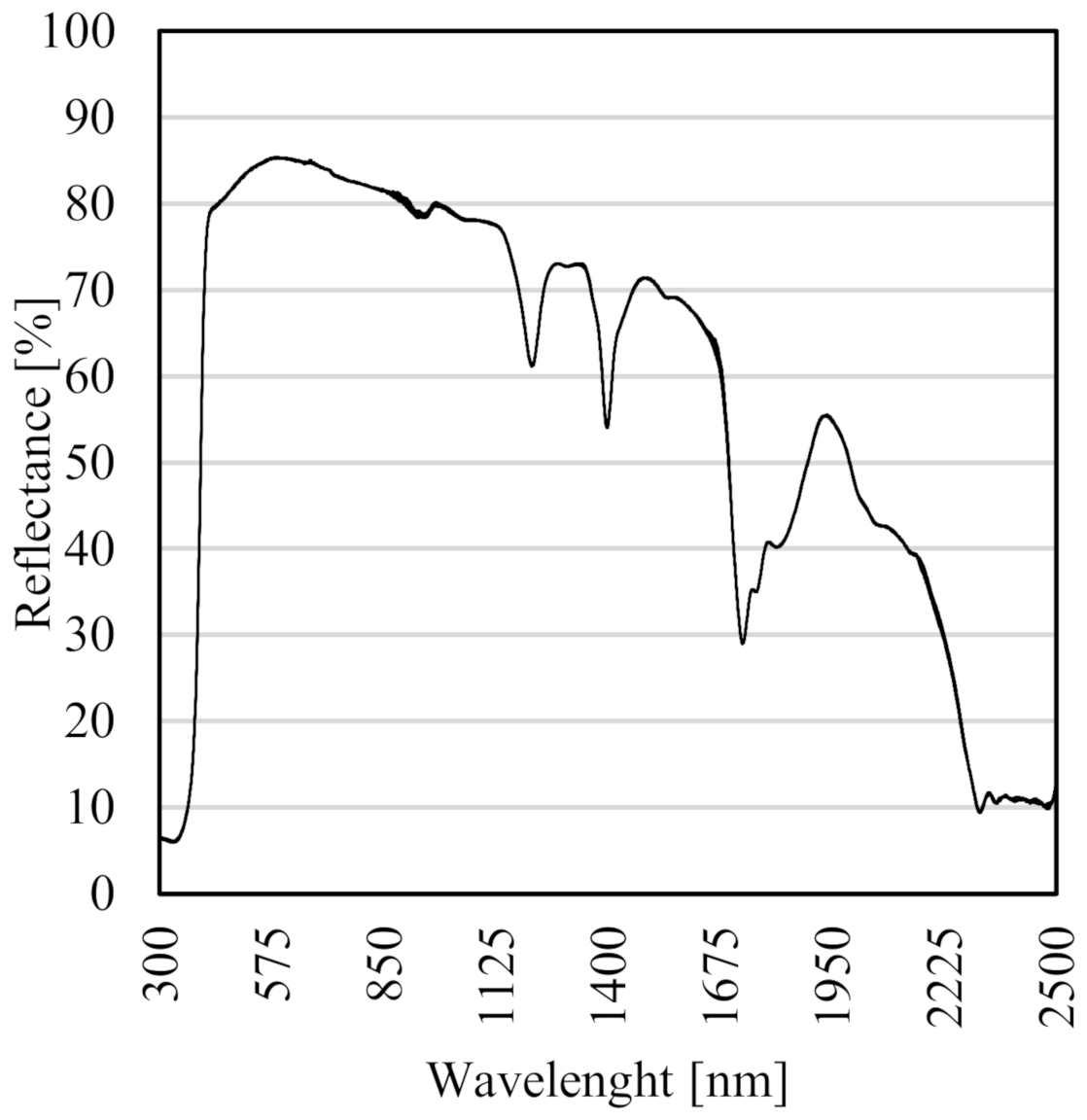

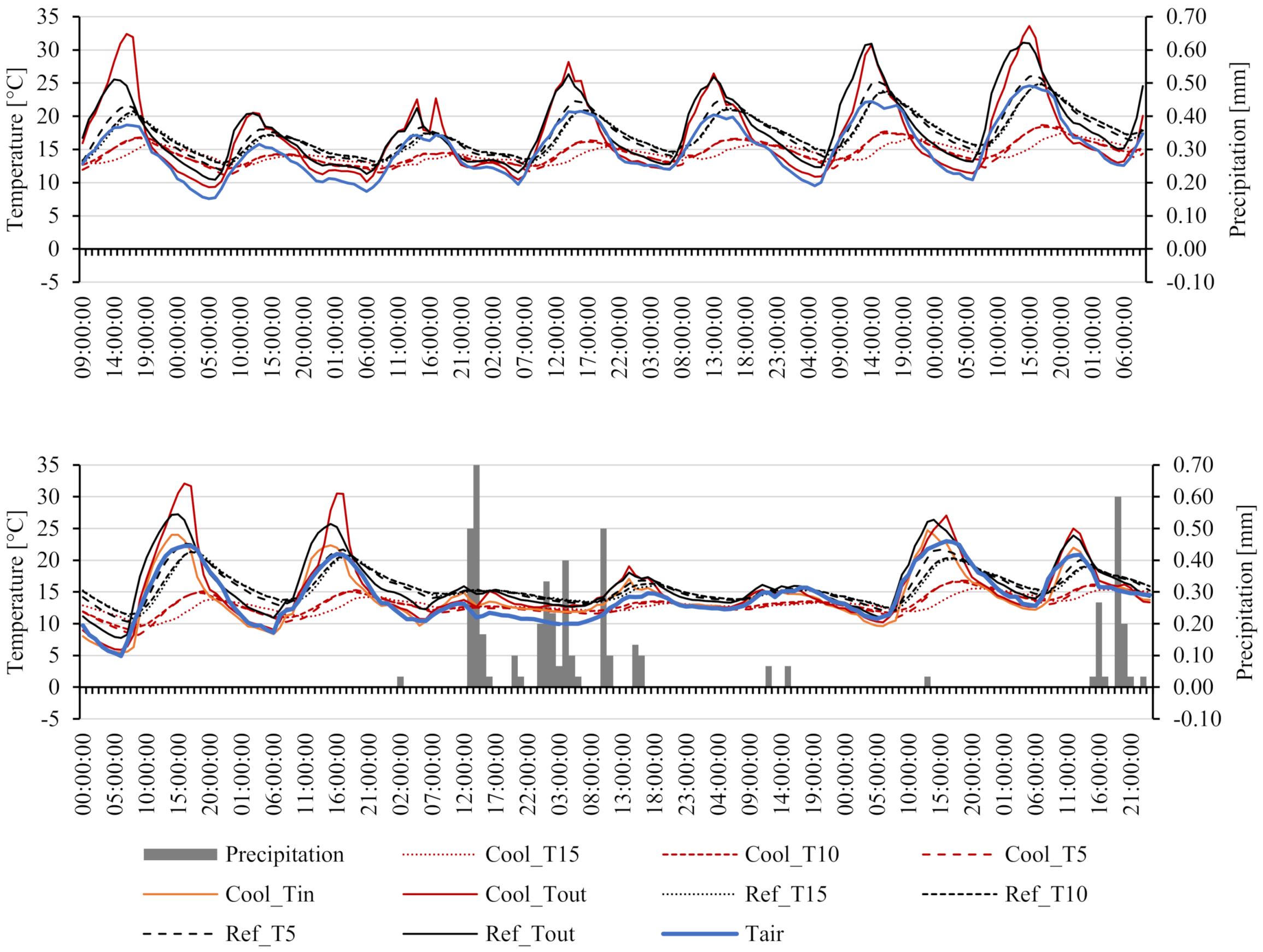
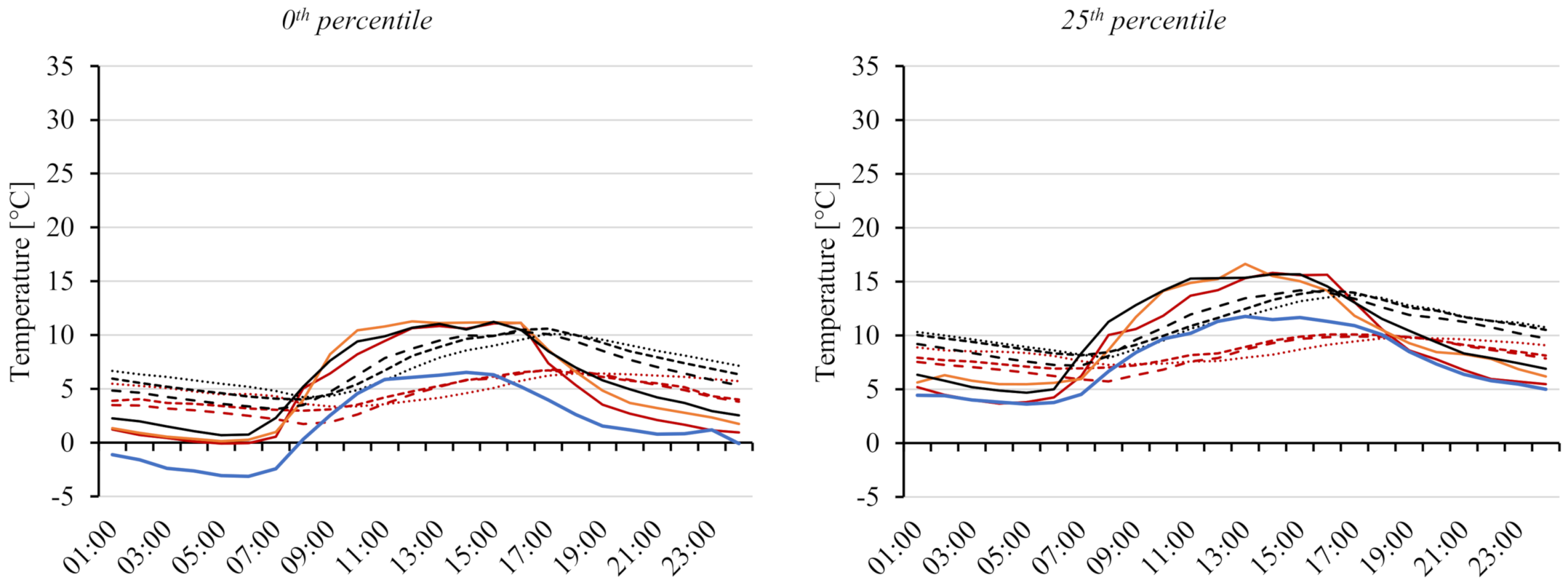
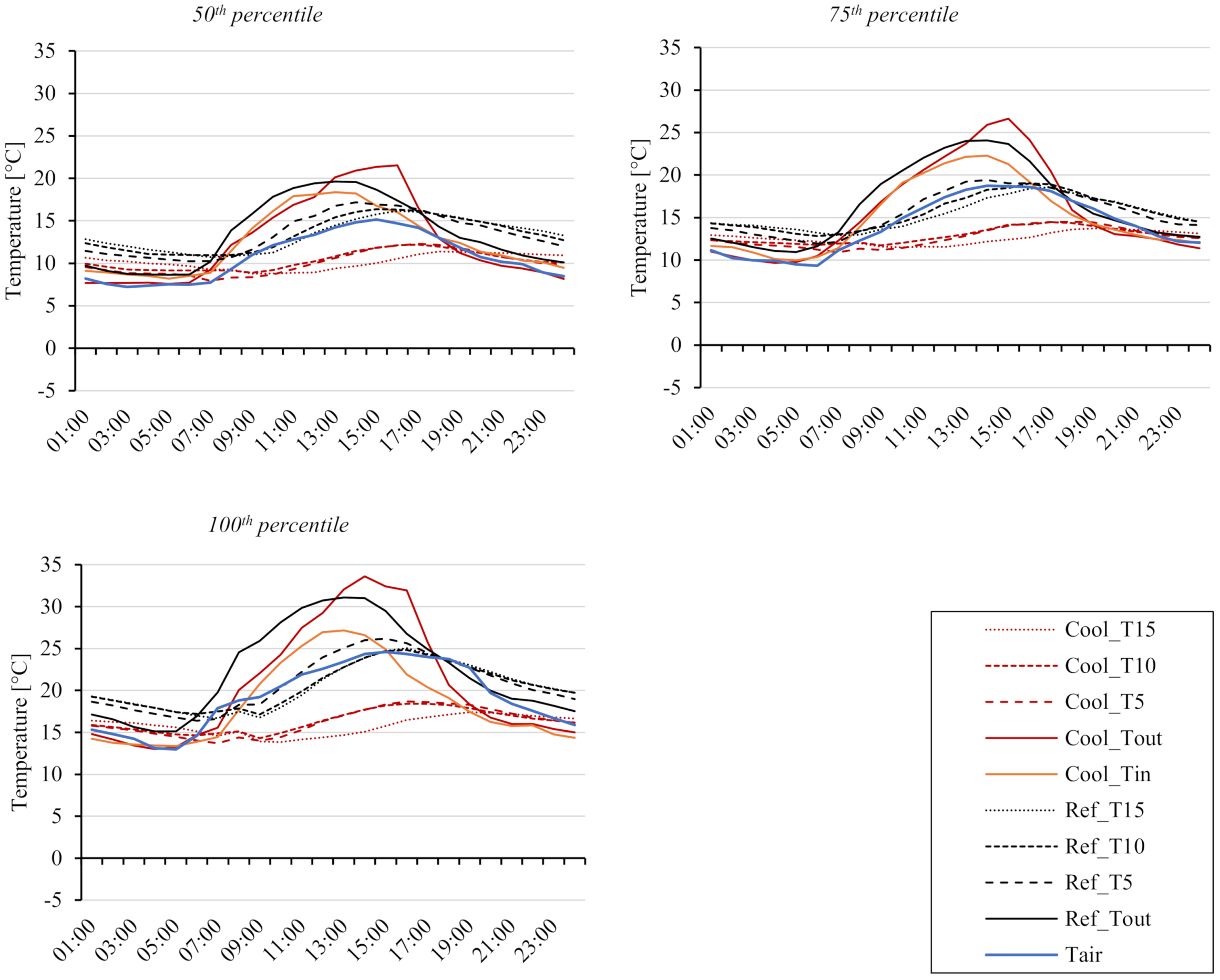
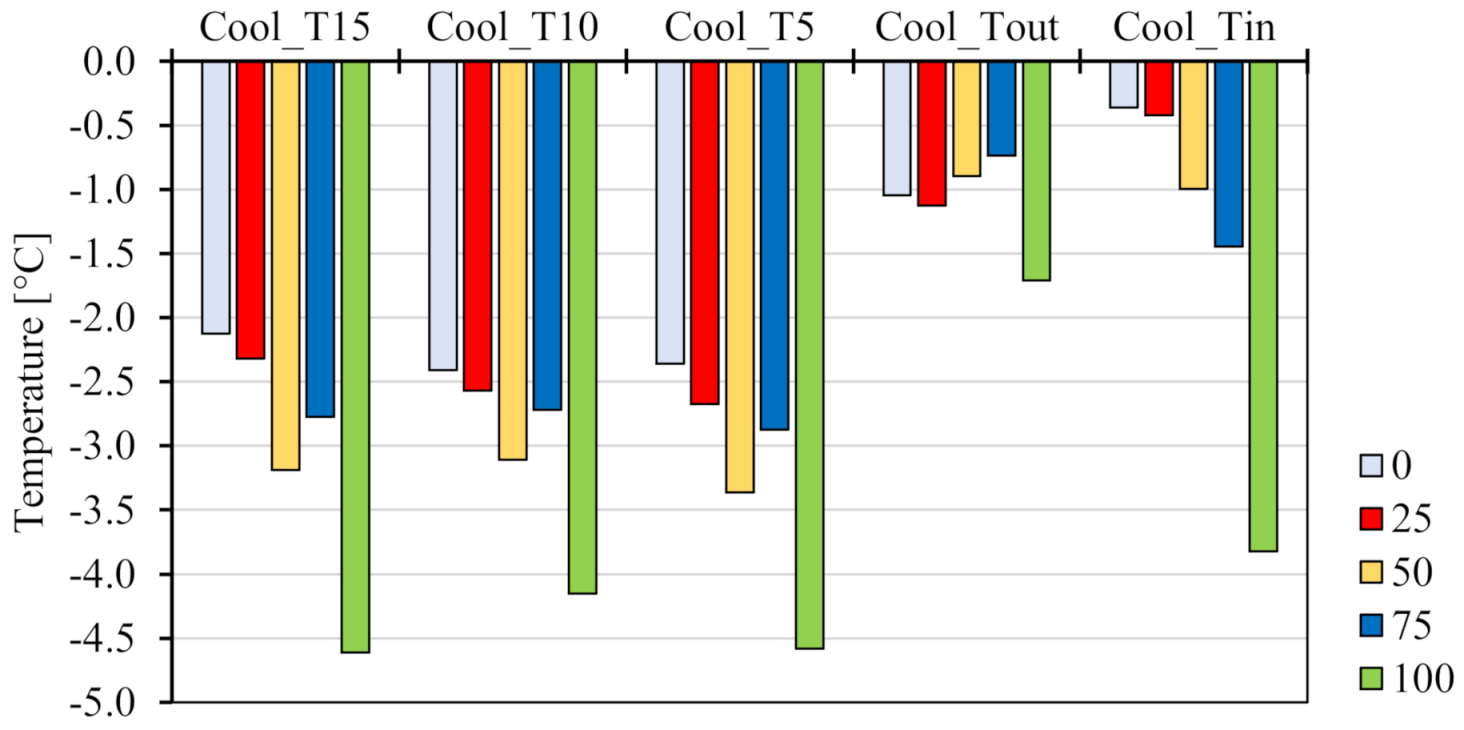
| Technical Characteristics | Testing Methods | Performance |
|---|---|---|
| Water vapor transmission property | EN 1931 (B) | 120,000 |
| Tensile strength in longitudinal | EN 12311-2 (B) | ≥5 N mm−2 |
| Elongation in the longitudinal | EN 12311-2 (B) | ≥300% |
| Tear resistance | EN 12 310-2 | ≥150 N |
| Dimensional stability | EN 1107-2 | ≤0.3% |
| Water tightness | ENN 1928 (B) | ≥500 kPa |
| Wavelength Interval | Spectral Reflectance | |
|---|---|---|
| Nominal Value | Error | |
| UV | 11.35% | 0.10% |
| Visible | 82.70% | 0.05% |
| IR | 55.25% | 0.10% |
| hc [Wm−2K−1] | SRI | |
|---|---|---|
| Nominal Value | Error | |
| 5 | 89.15 | 0.85 |
| 12 | 89.45 | 0.60 |
| 30 | 89.70 | 0.40 |
| Indicator | Cool_T15 | Cool_T10 | Cool_T5 | Cool_Tout | Cool_Tin | Ref_T15 | Ref_T10 | Ref_T5 | Ref_Tout |
|---|---|---|---|---|---|---|---|---|---|
| 0th percentile | |||||||||
| Tpeak [°C] | 6.4 | 6.7 | 6.8 | 11.1 | 11.3 | 10.1 | 10.6 | 10.3 | 11.2 |
| HoDpeak [h] | 19 | 17 | 17 | 16 | 12 | 17 | 17 | 16 | 15 |
| Tdaily,avg [°C] | 5.0 | 4.6 | 4.3 | 4.6 | 5.3 | 7.2 | 7.0 | 6.6 | 5.7 |
| th. attenuation [°C] | −4.7 | −4.4 | −4.3 | - | 0.1 | −1.1 | −0.6 | −0.9 | - |
| phase shift [h] | 3 | 1 | 1 | - | −4 | 2 | 2 | 1 | - |
| cooling potential [°C] | −2.1 | −2.4 | −2.4 | −1.0 | −0.4 | - | - | - | - |
| 25th percentile | |||||||||
| Tpeak [°C] | 9.8 | 10.1 | 9.9 | 15.8 | 16.6 | 13.8 | 14.2 | 14.2 | 15.7 |
| HoDpeak [h] | 19 | 17 | 17 | 14 | 13 | 17 | 16 | 15 | 15 |
| Tdaily,avg [°C] | 8.6 | 8.4 | 8.0 | 9.1 | 9.8 | 10.9 | 11.0 | 10.7 | 10.2 |
| th. attenuation [°C] | −6.0 | −5.7 | −5.9 | - | 0.8 | −1.9 | −1.5 | −1.5 | - |
| phase shift [h] | 5 | 3 | 3 | - | −1 | 2 | 1 | 0 | - |
| cooling potential [°C] | −2.3 | −2.6 | −2.7 | −1.1 | −0.4 | - | - | - | - |
| 50th percentile | |||||||||
| Tpeak [°C] | 11.4 | 12.2 | 12.3 | 21.5 | 18.4 | 16.2 | 16.4 | 17.2 | 19.6 |
| HoDpeak [h] | 18 | 17 | 17 | 16 | 13 | 16 | 15 | 14 | 13 |
| Tdaily,avg [°C] | 10.1 | 10.3 | 10.0 | 12.6 | 12.5 | 13.3 | 13.4 | 13.4 | 13.5 |
| th. attenuation [°C] | −10.1 | −9.3 | −9.2 | - | −3.2 | −3.5 | −3.3 | −2.4 | - |
| phase shift [h] | 2 | 1 | 1 | - | −3 | 3 | 2 | 1 | - |
| cooling potential [°C] | −3.2 | −3.1 | −3.4 | −0.9 | −1.0 | - | - | - | - |
| 75th percentile | |||||||||
| Tpeak [°C] | 13.7 | 14.5 | 14.5 | 26.6 | 22.3 | 18.6 | 19.0 | 19.4 | 24.1 |
| HoDpeak [h] | 19 | 17 | 18 | 15 | 14 | 17 | 16 | 14 | 14 |
| Tdaily,avg [°C] | 12.6 | 12.9 | 12.6 | 15.8 | 15.1 | 15.4 | 15.6 | 15.5 | 16.5 |
| th. attenuation [°C] | −12.9 | −12.2 | −12.1 | - | −4.4 | −5.5 | −5.0 | −4.7 | - |
| phase shift [h] | 4 | 2 | 3 | - | −1 | 3 | 2 | 0 | - |
| cooling potential [°C] | −2.8 | −2.7 | −2.9 | −0.7 | −1.4 | - | - | - | - |
| 100th percentile | |||||||||
| Tpeak [°C] | 17.4 | 18.4 | 18.7 | 33.6 | 27.2 | 25.0 | 24.8 | 26.2 | 31.1 |
| HoDpeak [h] | 19 | 16 | 16 | 14 | 13 | 16 | 16 | 15 | 13 |
| Tdaily,avg [°C] | 15.8 | 16.3 | 16.2 | 20.7 | 18.5 | 20.4 | 20.5 | 20.8 | 22.4 |
| th. attenuation [°C] | −16.2 | −15.2 | −14.9 | - | −6.4 | −6.0 | −6.3 | −4.9 | - |
| phase shift [h] | 5 | 2 | 2 | - | −1 | 3 | 3 | 2 | - |
| cooling potential [°C] | −4.6 | −4.2 | −4.6 | −1.7 | −3.8 | - | - | - | - |
Publisher’s Note: MDPI stays neutral with regard to jurisdictional claims in published maps and institutional affiliations. |
© 2021 by the authors. Licensee MDPI, Basel, Switzerland. This article is an open access article distributed under the terms and conditions of the Creative Commons Attribution (CC BY) license (https://creativecommons.org/licenses/by/4.0/).
Share and Cite
Manni, M.; Di Giuseppe, A.; Nicolini, A.; Sciurpi, F.; Cotana, F. Influences of a Highly Reflective Mulching Membrane on Heat Propagation throughout the Soil. Sustainability 2021, 13, 9737. https://doi.org/10.3390/su13179737
Manni M, Di Giuseppe A, Nicolini A, Sciurpi F, Cotana F. Influences of a Highly Reflective Mulching Membrane on Heat Propagation throughout the Soil. Sustainability. 2021; 13(17):9737. https://doi.org/10.3390/su13179737
Chicago/Turabian StyleManni, Mattia, Alessia Di Giuseppe, Andrea Nicolini, Fabio Sciurpi, and Franco Cotana. 2021. "Influences of a Highly Reflective Mulching Membrane on Heat Propagation throughout the Soil" Sustainability 13, no. 17: 9737. https://doi.org/10.3390/su13179737
APA StyleManni, M., Di Giuseppe, A., Nicolini, A., Sciurpi, F., & Cotana, F. (2021). Influences of a Highly Reflective Mulching Membrane on Heat Propagation throughout the Soil. Sustainability, 13(17), 9737. https://doi.org/10.3390/su13179737










